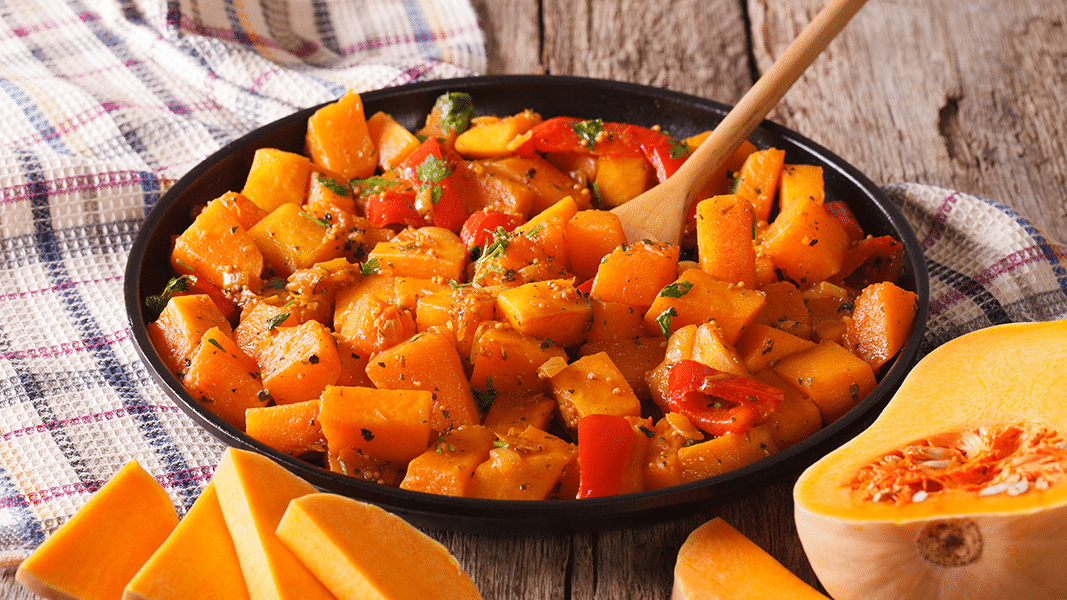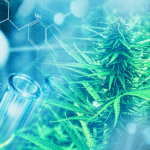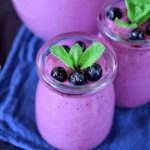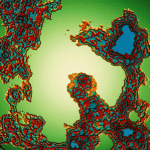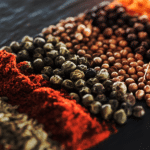Here’s a delicious recipe to enhance your overall health: pumpkins, spinach, beans, spices, and more. A warming and healing curry!
- 1 pumpkin
- Spices (to taste): turmeric, coriander, cumin, chili peppers, black pepper
- 1 onion
- 1 inch of ginger root
- 1 packet of spinach (400-700g)
- 1 red pepper
- Creamed coconut (50g)
- 1 tablespoon of coconut butter
- Fresh coriander leaves (100-150g)
- Dried black beans (soaked for 12 hours & boiled for 40 minutes)
Optional topping: lime slices and pumpkin seeds
Directions
Melt a tablespoon of coconut oil in a large pan. When completely liquid, add one chopped onion and fry until golden. Then add chopped ginger and garlic, and the curry spices: turmeric, coriander, cumin, chili peppers, black pepper (amount to your taste).
After a couple of minutes, add the chopped pumpkin. If the pumpkin is organic and you want to get as many nutrients as possible, keep the peel on. Cover with hot water and cook for 20 minutes. Add the chopped pepper, and cook for another 10 minutes. Next add the beans, the spinach, and the coriander leaves, along with the creamed coconut. Cook for 3 more minutes stirring well. For extra flavor and nutrients, serve with lime slices and pumpkin seeds.
Combine the curry dish with brown rice, or eat it a la carte. If desired, add salt and…enjoy!
Benefits
Pumpkin
Pumpkin flesh, seeds, and skin contain several phyto-consituents with medicinal properties:
- Tocopherols (also known as vitamin E) in the seeds protect the cells from oxidative damage.
- Alpha- and beta-carotenes, the orange pigments that give pumpkins, carrots, and sweet potatoes their characteristic color, act as anti-inflammatory agents. Studies have shown that alpha- and beta-carotenes reduce skin damage caused by UV-light and also prevent tumor formation, in particular prostate cancer. They also lower the risk of cataract development.
- Vitamin E and carotenes are lipid-soluble molecules, suggesting that they are more easily transported around and absorbed by our body when eaten together with fats, such as coconut oil. The oxidative properties of vitamin E and carotenes in pumpkins have been shown to reduce symptoms linked to diabetes, cardiovascular diseases, cancer and obesity.
Black Beans
Black beans are recognized as a good source of proteins, dietary fiber, vitamins, minerals, and a variety of phytonutrients with antioxidant and anti-inflammatory properties. The insoluble fiber in beans increases the volume of matter that travels through the gastrointestinal tract. As a result, carbohydrates such as glucose are slowly released into the blood circulation. This process is considered valuable in the prevention and management of different diseases, in particular diabetes. Furthermore, resistant bean starch ferments in the intestine, which results in the production of butyrate, a fatty acid that confers protective effects against colon cancer.
Ginger
Ginger roots are a powerhouse of nutrients. Commonly used in tea during flu season, ginger exhibits a wide range of biological activities, including anti-inflammatory, antioxidant, anticancer, anti-allergic, and antimicrobial properties. The compounds to which ginger owes its benefits are: gingerols, present in the fresh root, and shogaols, molecules derived from gingerols when ginger is dried or cooked.
Studies have shown that ginger extracts prevent the proliferation of tumor cells, have a protective effect against damage caused by radiation, and inhibit the activity of free radicals. These are responsible for damage to our cells, increasing the chances to develop DNA mutations and subsequently tumors.
Ginger is also shown a promising painkilling agent for women affected by dysmenorrhea. Compared to those who received no treatment, women experienced significantly less pain when ginger was administered in the first three days of their menstrual cycle. In studies that compared ginger with NSAIDs (nonsteroidal anti-inflammatory drugs, such as ibuprofen), it was shown that ginger was equally as effective as the anti-analgesic drug treatment.
Substantial research has shown that ginger exerts beneficial effects on patients undergoing chemotherapy. Gingerols and shogaols interact with the pathways involved in chemotherapy-induced vomiting and nausea, and significantly reduce these symptoms.
Spinach
Spinach leaves owe their green color to a pigment called chlorophyll. Recent studies have shown that chlorophyll binds to carcinogens, such as aflatoxin, and significantly reduces their absorption into the bloodstream. This means that chlorophyll can prevent DNA damage of human cells exposed to carcinogens, therefore lowering the risk of cancer development.
Significant research has also been done on dietary nitrate, a compound present, for example, in beetroot, spinach, and arugula. Nitrate is associated with a more efficient use of oxygen in athletes and people affected by chronic obstructive pulmonary diseases. By vasodilating blood vessels, nitrate significantly reduces blood pressure in people affected by hypertension and allows greater oxygen flow to the tissues. Dietary nitrate has been also linked to increased oxygen perfusion to the brain, leading to improved cognitive functions. This is of great importance for preventing and slowing down age-related cognitive decline and dementia.
Turmeric
Curcumin, a compound found in turmeric, is an anti-inflammatory and antioxidant agent that has been shown to confer beneficial effects for people affected by cancer, diabetes, cardiovascular diseases, and other chronic diseases linked to inflammation.
Inflammation is a protective response of the immune system to potentially harmful substances. As an anti-inflammatory response, the immune system generates leukocytes (white blood cells) that neutralise and digest foreign invaders such as bacteria, viruses, and cancerous cells. In doing so, leukocytes release free-radicals, which target the harmful substances, but also the surrounding cells. This can lead to unwanted tissue damage and, when inflammation is prolonged, to chronic diseases, such as cancer, diabetes, asthma, and cardiovascaular ailments. One can regulate inflammation by eating foods rich in turmeric.
Curcumin has also been shown to enhance the expression of the p53 protein, a molecule known as the guardian of the human genome. P53 is able to activate DNA repair proteins, therefore reducing the risk of unwanted mutations and tumor formation. Because curcumin is lipid-soluble, it is important to combine it with fats to promote its bioavailability and absorption into our body. Previous studies have also shown that piperine (a compound found in black pepper) intake can increase up to 20 times the uptake of curcumin.
This article is adapted from a recipe originally published by Nature Going Smart and may not be reprinted without permission.
Sources
- Daily, J. D. Zhang, X. Kim, D. S. Park, D. 2015. Efficacy of Ginger for Alleviating the Symptoms of Primary Dysmenorrhea: A Systematic Review and Meta-analysis of Randomized Clinical Trials. Pain Medicine. 16: 2243-2255.
- Ferruzzi, M. G. Blakeslee, J. 2007. Digestion, absoprion, and cancer preventative activity of dietary chlorophyll derivatives. Nutrition Research Journal. 27(1): 1-12.
- Hayat, I. et al. 2014. Nutritional and Health Perspectives of Beans (Phaseolus vulgaris L.): An Overview. Critical Reviews in Food Science and Nutrition. 54(5): 580-592.
- Jubert, C. et al. 2009. Effects of chlorophyll and chlorophyllin on low-dose aflatoxin B1(1) pharmacokinetics in human volunteers. Cancer Prevention Research. 2(12): 1015-1022.
- Kapil, V. et al.2015. Dietary Nitrate Provides Sustained Blood Pressure Lowering in Hypertensive Patients: A Randomized, Phase 2, Double-Blind, Placebo-Controlled Study. Hypertension. 65: 00-00. DOI: 10.1161/HYPERTENSIONAHA.114.04675
- Kenjale, A. A. et al. 2011. Dietary nitrate supplementation enhances exercise performance in peripheral arterial disease. Journal of Applied Physiology. 110(6): 1582-1591.
- Khodaie, L. Sadeghpoor, O. 2015. Ginger From Ancient Times to the New Outlook. Jundishapur Journal of Natural Pharmaceutical Products. 10(1): e18402.
- Kim, M. Y. et al. 2. Kim, M. Y. et al. 2012. Comparison of the chemical compositions and nutritive values of various pumpkin (Cucurbitaceae) species and parts. Nutrition Research and Practice. 6(1): 21-27.
- Kunnumakkara, A. B. et al. 2016. Curcumin, the golden nutraceutical: for multiple chronic diseases. British Journal of Pharmacology. doi: 10.1111/bph.13621
- Marx, W. et al. 2017. Ginger-Mechanism of action in chemotherapy-induced nausea and vomiting: A review. Critical Reviews in Food Science and Nutrition. 57(1): 141-146.
- Rakoff-Nahoum, S. 2007. Why Cancer and Inflammation? Yale Journal of Biology and Medicine. 79(3-4): 123-130.15. Bohn, T. 2014. Dietary factors affecting polyphenol bioavailability. Nutrition Reviews. 72(7): 429-452.
- Ryan, L. et al. 2008. Micellarisation of carotenoids from raw and cooked vegetables. Pland Foods for Human Nutrition. 63 (3): 127-133.
- Semwal, R. B. et al. 2015. Gingerols and shogaols: Important nutraceutical principles from ginger. Phytochemistry. 117: 554-568.
- Yadav, M. et al. 2010. Medicinal and biological potential of pumpkin: an updated review. Nutrition Research Reviews. 23: 184-190.

